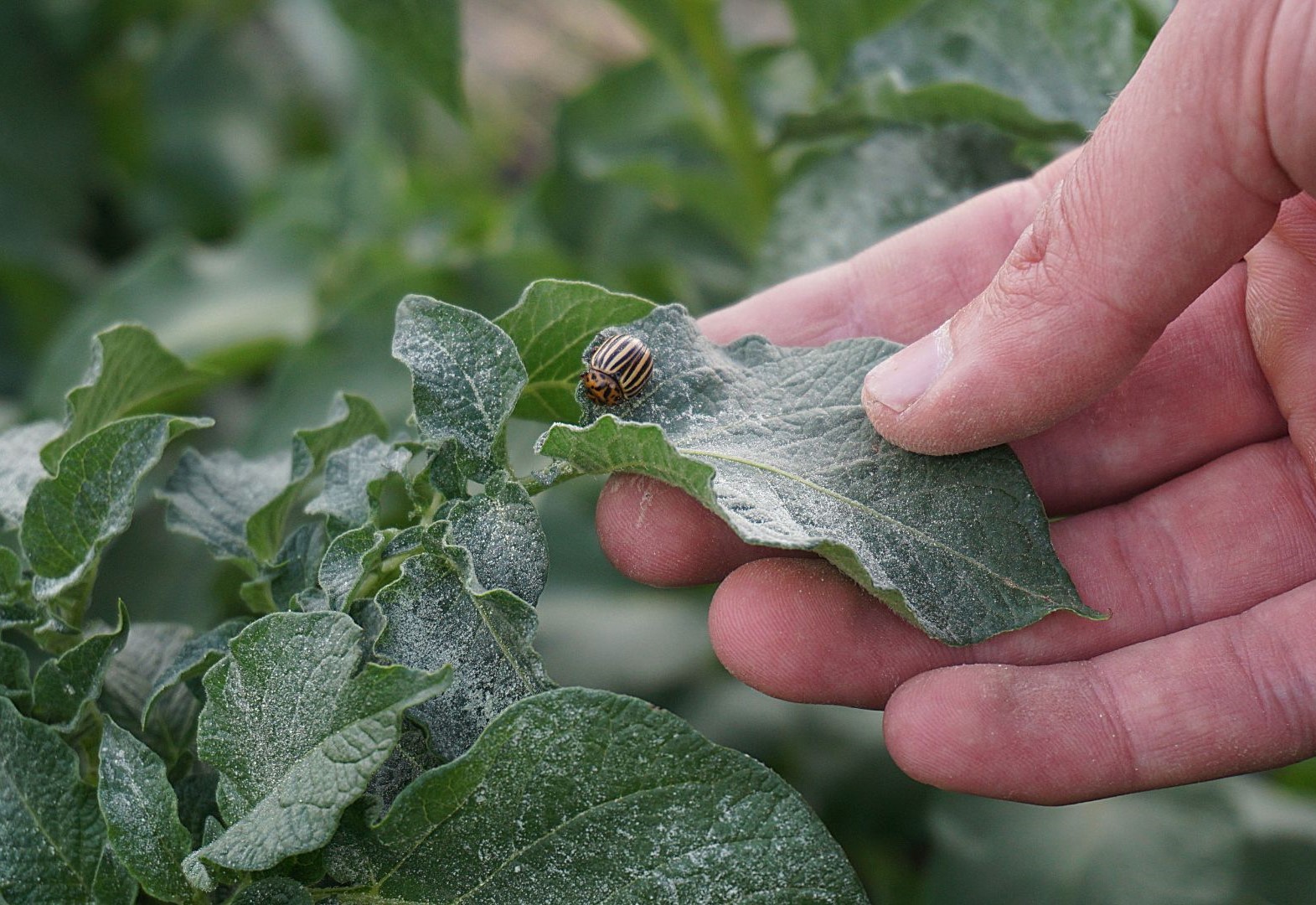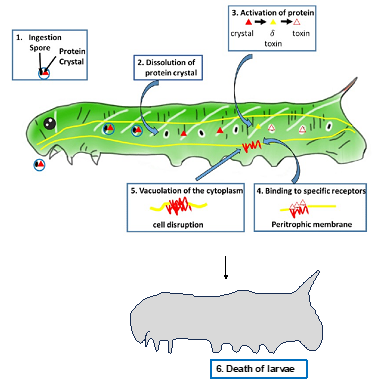Bacillus species: A Green Solution for Sustainable Crop Production

This post is also available in:
This post is also available in:
![]() Ελληνικά (Greek)
Ελληνικά (Greek)
The growth of the global population has brought about an escalated need for food resources. Traditional farming practices heavily rely on chemical fungicides/pesticides to control pests and pathogens, causing detrimental effects on human health and the environment. Exploring alternatives to chemical fertilizers or pesticides is necessary for sustainable and environment-friendly agriculture. Bacillus species is a naturally occurring bacteria having remarkable biocontrol properties. These bacteria have already gained significant attention for their ability to combat phytopathogens and pests while minimizing harm to beneficial insects, humans, and the environment.
Bacillus species
Bacillus spp. is a naturally occurring rod-shaped, Gram-positive, aerobic or facultatively anaerobic, and catalase-positive bacterium. They can produce endospores and potentially survive in adverse conditions. They are predominantly available in soil, rhizosphere and are treated as the most widespread endophytic bacteria. Bacillus spp. is a large and diverse group of non-pathogenic bacteria, and most Bacillus species and their products are considered environmentally safe for use. Some of the most common and beneficial Bacillus species include B. subtilis, B. amyloliquefaciens, B. licheniformis, B. thuringiensis, B. megaterium, B. velezensis, B. cereus etc. Bacillus spp. are widely used for eco-friendly sustainable agriculture due to their plant growth-promoting attributes, bio-fungicidal, bio-insecticidal, and bio-nematocidal properties (Surovy et al., 2022).
How does Bacillus spp. promote plant growth and nutrient uptake?
Bacillus promotes plant growth through nutrient uptake, nitrogen fixation, phosphorus solubilization, and the production of growth-promoting hormones.
Bacillus spp. can directly uptake nutrients from the environment. They can produce nitrogenase enzymes to catalyze the conversion of dinitrogen (N2) to ammonia (NH3), which help the plant to uptake nitrogen from the environment and reduce the use of chemical nitrogen fertilizers for crop production. Most of the Bacillus spp. contain the nifH gene, which plays a role in atmospheric nitrogen fixation and helps to increase total nitrogen content and biomass accumulation in plants. Plant growth is also directly related to phosphorus availability, and more than 80% of phosphorus is unavailable for plant uptake. However, Bacillus spp. can solubilize inorganic phosphorus and mineralize insoluble organic phosphorus. As a result, plants can uptake phosphorus directly from the soil. Moreover, they can produce siderophores, auxins, gibberellins, and cytokinins, which can help increase plant growth and yield. B. amyloliquefaciens can produce abscisic acid, which helps plants resist salinity stress (Surovy et al., 2022).
How does Bacillus spp. control plant pathogens?
Bacillus controls phytopathogens through competition, antibiotics, and antimicrobial metabolites and induces systemic resistance.
Bacillus spp. can produce different types of antibiotics and enzymes to control phytopathogens. It competes with phytopathogens for nutrition and space. Indirectly it also induces plant systemic resistance against pathogenic or pest infestation. Therefore, the induction of systemic resistance by Bacillus spp. provides better protection and induce resistance to pest and pathogens. Bacillus pp. increases the activity of antioxidant enzymes and produces antimicrobial secondary metabolites (bacilicin, fengycin, bacillbactin, piplastin, etc.) and volatile organic compounds, which help to biologically control pathogens and pests.
(Borah et al., 2023)
How does Bacillus spp. act as nematicide?
Roots colonized Bacillus produces nematicidal toxins, volatile compounds, and secondary metabolites that degrade nematode cuticles and disrupt eggshells.
Bacillus spp. produce resistant endospores to survive in the environment for a longer time. These spores can colonize into plant roots and are ubiquitous within the rhizosphere. These groups of bacteria produce different types of proteolytic enzymes like sphingosine (nematicidal toxin), superoxide dismutase, peroxidase, nematicidal volatiles like 2-nonanone, dimethyl disulfide, and secondary metabolites which degrade the cuticle of the nematode and increase toxicity. As a result, paralysis and mortality of nematode occur. These metabolites and toxic enzymes also disturb the eggshell of the nematode and potentially control the nematode. So, undoubtedly Bacillus spp. is an ideal bacterium for the biocontrol of nematodes, and the US Food and Drug Administration (USFDA) declared Bacillus species as “generally regarded as safe.”
How does Bacillus thuringiensis (Bt) act as a bio-insecticide?
Among the Bacillus spp., Bt is currently available as a registered pesticide product. Bt products are used on crops and ornamental plants for aerial application. It is suitable for organic agriculture. Generally, common Bt products are found in the market as sprays, granules, dusts, concentrates, and pellets.
Bt produces an insecticidal protein that can destroy the cells of the insect’s gut, paralyzing the insect that usually dies from infection or starvation.
Upon sporulation, Bt produces crystal proteins known as Cry toxins (Fig. 1A). The Cry proteins (Cry toxins) constitute the largest group of insecticidal proteins produced by Bacillus species. To date, the Bt Toxin Nomenclature Committee has classified 73 different types of Cry proteins (Cry1 to Cry73), which are well-documented for their toxicity against lepidopterans, coleopterans, hemipterans, dipterans, nematodes, including human and animal parasites (Rhabditida), and snails (Fig. 1B).
When insects eat Bt, the crystal toxins are solubilized in their midgut. Following proteolytic activation by midgut proteases, the toxins bind to specific receptors on the insect cell membrane. This binding leads to cell disruption, the subsequent breakdown of the insect gut lining, and eventual paralysis. Later the death of insect larvae occurs due to infection and starvation (Fig. 2). The death of insects occurs within 1-5 days, and young insect larvae are mostly affected (Yul et al., 2007). 
Figure 1. (A) Protein crystals and Bt spores under an electron microscope; (B) Host spectrum of Bt toxins (Palma et al., 2014)
 Figure 2. Mechanisms of Bt toxin to control insect pests (Wijerathna-Yapa, 2017).
Figure 2. Mechanisms of Bt toxin to control insect pests (Wijerathna-Yapa, 2017).
Bt crops
Through genetic engineering, transgenic crops are introduced by inserting crystal protein genes (Cry genes) from Bacillus thuringiensis into the genome of crops. These transgenic crops are resistant to insect pests. There is a controversy about using genetically modified crops. Therefore, only some crops are approved for cultivation in farmers’ fields.
List of Bt crops approved for cultivation
| Crop | Target pest | Approved country |
| Bt corn | Corn rootworm, corn earworm | Spain, Portugal, Romania, Czech Republic, and Slovenia |
| Bt cotton | Pink bollworm, fall armyworm | India, China |
| Bt brinjal | Shoot and fruit borer | Bangladesh |
Is Bt harmful to humans?
Bt spores damage the gut of insect larvae after the larvae eat them. The insect gut is alkaline (pH of 9.0 to 10.5), and Bt requires highly alkaline conditions to release specific enzymes for the activation of Bt toxins. Hence, the human/mammal gut is more acidic with low pH. So, they do not release specific enzymes that break down the spore proteins to activate the Bt toxins. Therefore, based on this current scientific knowledge, Bt does not have any significant risks to human or mammal health.
The Fate of Bt toxins in the Environment
Bt spores are typically found in the top few inches of soil and can remain dormant under most natural soil conditions. However, their survival and growth in soil depend on soil conditions and soil properties. Bt from the soil can naturally settle on plant leaves through various means, including rain splashing, deposition by animal feces, sprouting seeds, or infected insects. It has been found in various aquatic environments and can enter natural water sources through rain, wind, animal feces, and runoff. Bt toxins are very host-specific and these toxins are broken down in leaf surfaces by natural factors such as sunlight’s ultraviolet (UV) light, weather conditions, and plant enzymes.
Additionally, spores can be washed off the leaf surface by rainfall. Bt toxins generally degrade faster than spores, with half-lives ranging from less than a day to 46 days. However, traces of the toxin can persist in the soil for up to six months. The typical lifespan of Bt toxins on foliage ranges from one to four days. The persistence and movement of Bt depend on soil conditions, sunlight exposure, and natural processes like rainfall and runoff. These dynamics influence the breakdown and distribution of Bt spores and toxins, ensuring their presence in different ecological settings and without causing any harm to the environment.
Finally, Bacillus species is an important beneficial group of bacteria embodied with biocontrol potential. Its ability to target specific pests and pathogens, sustainability, and compatibility with integrated pest management approaches make it an attractive option for farmers seeking environmentally friendly and effective pest management solutions. By harnessing the power of Bacillus biopesticides or bio-fungicides, farmers can protect their crops while minimizing the negative impacts on beneficial organisms and the ecosystem as a whole.
References
Borah, P.; Gogoi, N.; Asad, S.A.; Rabha, A. J.; Farooq, M. (2023). An Insight into plant growth-promoting rhizobacteria-mediated mitigation of stresses in plant. J. Plant Growth Regul. 42, 3229–3256. doi:10.1007/s00344-022-10787-y.
Palma, L.; Muñoz, D.; Berry, C.; Murillo, J.; Caballero, P. (2014). Bacillus thuringiensis toxins: an overview of their biocidal activity. Toxins 6(12), 3296-3325. doi: 10.3390/toxins6123296.
Surovy, M.Z.; Rahman, S.; Dame, Z.T.; Islam, T. (2022a). “Discovery of bioactive natural products from bacillus species: Chemistry, biosynthesis and biological activities” in Bacilli in agrobiotechnology. Bacilli in climate resilient agriculture and bioprospecting, eds. Islam, M.T.; Rahman, M.; Pandey, P. (Springer, Cham), 47-87. doi:10.1007/978-3-030-85465-2_3.
Wijerathna-Yapa A. (2017). Transgenic plants: resistance to abiotic and biotic stresses. J. Agricul. Environ. Int. Dev. 111(1), 245-275. doi: 10.12895/jaeid.20171.643.
Yul, R. J.; Choi, J.Y.; Li, M. S.; Jin, B.R.; Je, Y.H. (2007). Bacillus thuringiensis as a specific, safe and effective tool for insect pest control. J. Microbial. Biotechnol. 17(4), 547-559.
Further reading
Innovations & Technologies for Smarter Integrated Pest Management









































































